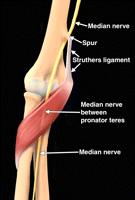


This pronation movement can lead to the pronator teres muscle hypertrophy and compression of the median nerve. This problem is common in mechanics, carpenters, tennis players, rowers, and weight lifters. Prolonged or repetitive grasping or forceful pronation movement of the forearm, i.e., turning the forearm into a “palm down” position.The main causes of pronator teres syndrome include Pronator teres muscle functions as a “rotator” that turn your forearm into a “palm down” position (pronation). The median nerve gets compressed or entrapped by the bony spur (medial supracondylar spur) and ligament of the Struthers. This bony spur (medial supracondylar spur) is connected to the medial epicondyle by the Ligament of Struthers. In 1% of cases, there is a radiological finding called a medial supracondylar spur, about 5cm proximal to the medial epicondyle. The contraction of this muscle brings about pronation movement of the forearm. Both the heads fuse and go transversely to attach on the shaft of another major bone of the forearm, the Radius. After that, it leaves the cubital fossa by passing between the two heads of the pronator teres muscle.Īnatomy of the pronator teres muscle – One head originates from the humerus, and the other head from the ulna.Then, it runs medial to the brachial artery, runs under the biceps muscles, and enters into the cubital fossa.

In the arm initially, it lies lateral to the brachial artery, then it crosses in front (anteriorly) over the brachial artery to reach its medial side.The arm’s anterior (flexor) compartment contains three muscles (Biceps brachii, brachialis, and coracobrachialis). After originating from the brachial plexus, the median nerve enters the anterior compartment of the arm.Let’s discuss the origin of the median nerve. That’s why it is called the median nerve. The median nerve runs in the medial plane of the forearm.As you can see in the diagram, one branch is coming from the lateral cord, and one branch is coming from the medial cord, and together they form the median nerve. The median nerve is formed by the lateral and medial cord of the brachial plexus.The course of the median nerve (origin and insertion) How the median gets compressed, and the outcomes and treatment of the Pronator Teres Syndrome. Now, let’s understand the course of the median nerve (origin and insertion). By the Fibrous arch of the origin of Flexor Digitorum Superficialis muscle.Due to the thickening of the bicipital aponeurosis.Between the two heads of the pronator teres muscle.


 0 kommentar(er)
0 kommentar(er)
